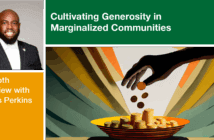Ken Sloane of Discipleship Ministries shares ten ideas for church financial leaders to help sustain the church and its ministries in the face of interruptions caused by the coronavirus outbreak.
Numerous good resources are available for churches about how to prepare for the reality of the spreading COVID-19 virus. The following list of ideas is specifically directed to financial leaders across the church to help with sustaining the church and its ministry (and perhaps growing it in areas) as we live through these COVID-19 days.
1. The digital giving debate has heard the last word: coronavirus.
If you have already set up for people to give electronically to your church, you have a head start in weathering whatever the COVID-19 storm brings. If you haven’t found a vendor and signed on, there is no time better than today. Start comparing providers, talk to other churches about their experience, and read reviews online. If you’re not ready to make a commitment to embrace online giving options, consider setting up something to get you through this difficult time. PayPal, just one example, will offer charitable organizations an online donation service with a low fee of 2.2 percent and .30 per transaction. Some of your members may already have PayPal accounts.
2. Encourage members to look into billpay.
Ask your members to see if their banks offer a “BillPay” option. They can set up the church as a regular payment they make, and the bank generates an electronic check and sends it via USPS (United States Postal Service). The bank I use doesn’t charge for this, and it even covers the postage!
3. Give passing the plates a break. Position baskets in convenient places.
Because of the COVID-19 outbreak, people need to be conscious of what they touch that has been touched by others; and in churches, that includes offering plates. During this time of heightened virus awareness, you may want to consider placing boxes or baskets (or the offering plates themselves) in convenient places, so people can leave their offerings without handling an offering plate that others have handled.
4. Counters handle dirty dollars. Take precautions.
Unfortunately, offering envelopes and cash provide an effective vehicle for transmitting this very hardy virus. Provide your counters with hand sanitizer and gloves (be conscious that some people are allergic to latex) as they do their work of counting and recording. Make sure counters space themselves at a distance from one another. The image of a counter licking his or her finger before counting a stack of bills should set off alarms from your church to the CDC. Take precautions!
5. Sunday gatherings may become a problem. Have a “Plan C.”
We hope that your church leaders have already discussed and put in place some steps to minimize the exposure of Sunday attendees to a highly contagious virus. However, if your plans have not included what you will do if you are not able to open your doors for worship on Sundays, you haven’t planned far enough. Being prepared to have a worship experience via video streaming or Facebook Live (make sure you have proper licensing permissions), or through video or audio-conferencing technology to keep your congregation connected is essential.
6. Schedule giving reminders for Sunday delivery.
If you are already using email for the delivery of newsletters and other church communications, it’s OK to set up a scheduled email to go out Saturday night or early Sunday morning to remind people that the need for their giving and support continues, even if the church has cut back or has had to cancel gathering and corporate worship services.
7. Be conscious of the income impact on members.
For some of your members, the present coronavirus crisis will not affect their incomes. Some will be offered the opportunity to work at home, which well be a savings opportunity. Not everyone, though, will be in that situation. Some will see their income seriously affected by the social distancing that is attempting to slow the spread of the disease. Things like traveling, going out to dinner, cutbacks in entertainment, reduced hours, or overtime all carry potential hardships for people who were already just getting by. Make sure your church is conveying this sensitivity in all its communications.
8. Older members seem more at risk. Reach out regularly.
We have been hearing through media accounts that older people are more susceptible to the COVID-19 virus. Be sure that you are taking extra care to keep in contact with older members. Just as you develop a plan for worship alternatives, a strategy for pastoral care is important in these days. This does not have to fall totally on the pastor and staff, but laity who have the gifts can be recruited to call and check in on a list of older members on a regular basis. It’s not hard to imagine that fear of going out to even the grocery store may put some people in need of basic food supplies. Just because other programming may be affected by the virus precautions, your church needs to continue—and maybe even strengthen—these basic caring connections through this crisis.
9. Consider a coronavirus assistance fund.
It’s a fact. In a time of hardship, people look for a place to give. Consider offering your congregation (or the community as a whole) an opportunity to provide designated giving to a coronavirus assistance fund. A scarcity mindset may tell you that people will divert money they would give to your church operating budget, but this is rarely the case. Setting up such a fund will require a meeting of your finance committee to organize the fund and set guidelines; your church council may need to approve it. Both meetings could be done by phone or video conference, if necessary. You will be impressed with the generosity of people, and you will remind your members and community that you care and are ready to be in ministry no matter what comes your way!
10. Send messages of hope, encouragement, and impact.
It seems clear that church life is going to be affected by this crisis. As you communicate with your congregation, be a voice of hope and encouragement – we will get through this. Knowing that one of the main reasons people give to any charitable organization is “belief in the mission,” try to celebrate in your communications that the church continues to make an impact. Tell stories of people your congregation has helped, of lives that they have nurtured and shaped by their giving.
The article was originally posted to the website of Discipleship Ministries of the United Methodist Church. Used by permission.
Related Resources
- 6 Steps Your Congregation Should Take in Response to the Coronavirus by Tom Pruski
- Does Your Church Need a Disaster Ministry Plan? by Jamie D. Aten And David M. Boan
- Lead, Learn, Launch: Getting Started with Digital Giving by Alex Benson






